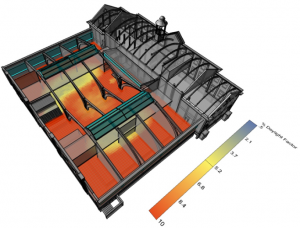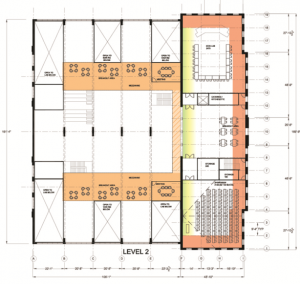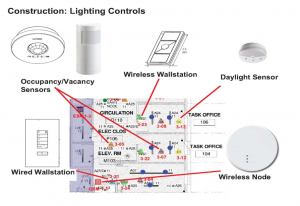CBEI researchers have moved into their new home in November of 2014 at The Navy Yard in Philadelphia. The new headquarters building was designed as a living laboratory for building science researchers to test the real-world application of a number of energy conservation measures. The building, a deep retrofit of a 1940s Navy recreation center, takes advantage of a tight building envelope and incorporates three distinct building areas that anticipate distinct occupancy patterns, each with a distinct fit-for-purpose HVAC system (see HVAC Design to Occupancy). Extensive use of ‘off-the-shelf’ daylighting, shading, energy efficient lighting and controls solutions were also deployed by the design team. This gives researchers the chance to compare the systems’ performance with the design projections.
CBEI Investigators began occupying the building even as workers were still adding some final touches to the headquarters building and the systems were still being commissioned. CBEI’s Demonstration Program Manager, Mark Stutman, took advantage of this period of fine-tuning to hold two post-construction meetings with key project stakeholders. An HVAC Design Intent meeting took place in February, followed by a Lighting Design Intent meeting in March. This meeting was of value, as it allowed the design and construction stakeholders to communicate the lighting, daylighting and shading design intent of the building, identify compromises made during construction, and emphasize system and operational issues that will be of value to the building managers and occupants in providing a comfortable building. It was also an opportunity to bring the new contract building management firm up to speed on the complexities of the system and challenges that remain through the commissioning phase. Along with CBEI researchers and the building managers (Athenian-Razak), the meeting was attended by lighting design consultants (Bruce Brooks and Associates), and the lighting system and fixture provider (Lutron Systems).
The greatest challenge discussed at the meeting is that the motorized operable shades installed below the two sets of skylights in the atrium apparently can only be controlled ‘on/off’ as one group to control glare and overheating, not individually to optimize lighting levels as intended.
The CBEI Lighting Design to Occupancy meeting provided the opportunity for all stakeholders to review the installed building systems and challenges, and begin to operate the building as designed.



